How To Accelerate API Integration with Behavioral Emails and Developer Segmentation
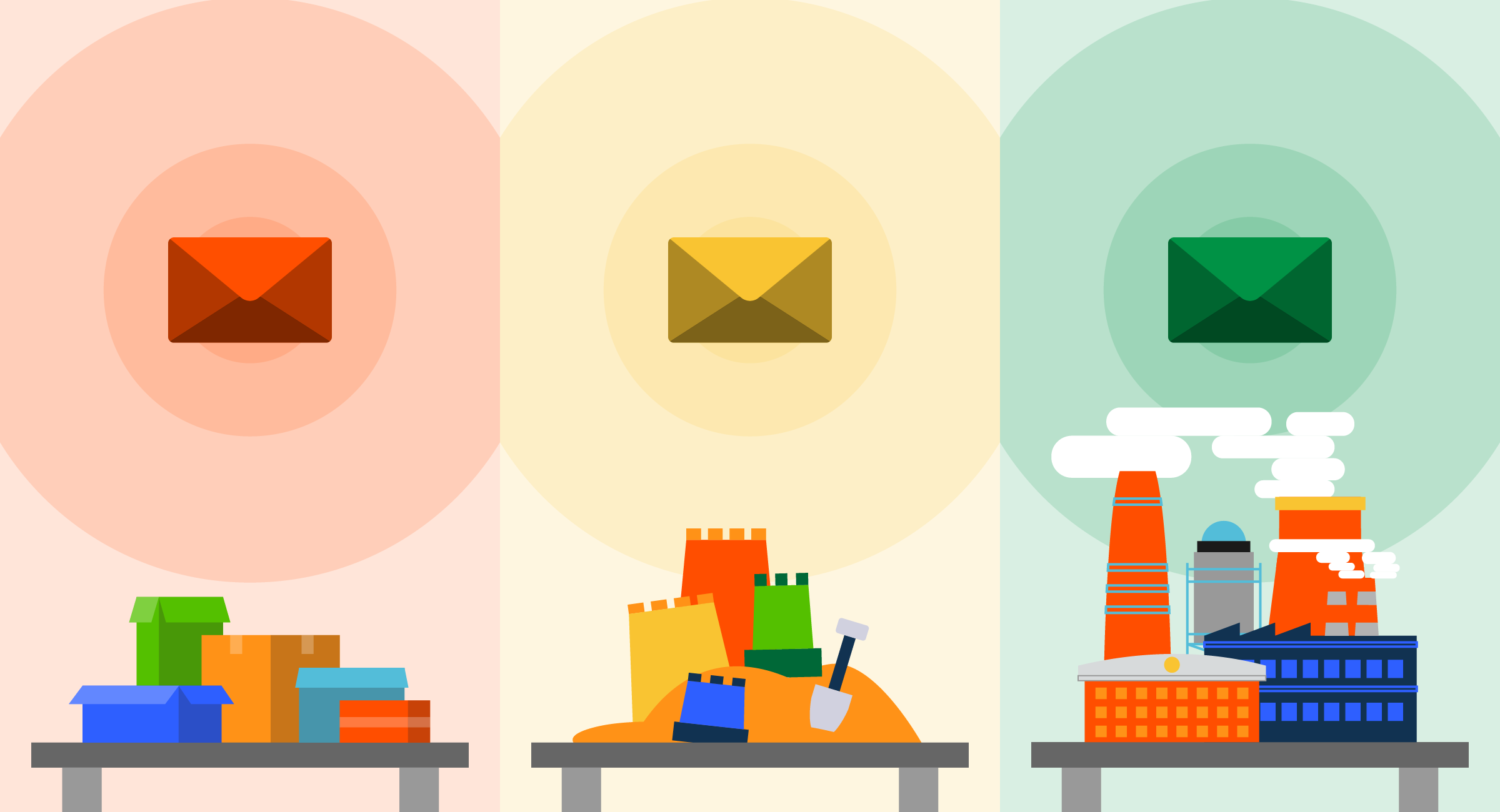
Behavioral email is the keystone of user-centric platform integration — emails to developers are most effective when they’re based on how they used your platform. Not surprisingly, the concept of segmenting your customers into groups of similar behaviors or attitudes is a well established best practice in marketing.
MarketSherpa’s survey found that one of the most effective marketing strategies is to send emails based on the behavior of your customers. Familiar examples in the B2C world include, notification that a service was signed up for but registration wasn’t completed, receipt of collateral after a form submission, and invitation to check out after a shopping cart was abandoned.
Behavioral email can also be a highly effective means of communication for API platform companies helping developers speed API integration and try out new product features, whilst keeping them informed on subscription and platform issues.
Table of Contents
- Why Behavioral Email in API-First Companies
- Steps to Speed API Integration
- Try Unused API Product Features
- Keep Informed on Subscription and Platform Issues
Why Behavioral Email in API-First Companies
Behavioral email is automated and targeted messages sent to customers based on their actions or behavior. By triggering on how your customers interact with your website or product, you’re able to send email whose content is actually aligned with what they’re doing, and will therefore be far more likely to resonate.
In API platform companies the triggering behavior is often around API product parameters such as event count, endpoint utilization, status codes, etc. Our own customers have examined sending different messages around certain actions and user types.
Within Moesif, we’ve moved away from static drip campaigns for new trial sign ups, to customized automated emails. By focusing on what customers have done in their onboarding process, we’re taking Account Based Marketing (ABM) to the next level. By combining targeting by role or industry with how much engagement there’s been with our product, we’ve seen a marked increase in customer integration.
Steps to Speed API Integration
Increasing your API integration rate can be achieved by providing relevant content to your audience, and the easiest way of doing that is to segment your customers into buckets of similar characteristics. For each cohort, create an email campaign, or workflow sequence, targeting the behavioral characteristics of the group.
1. Segment by Job Category
Upon signing-up, new users should pick a role. For API platform companies a representative list of job functions includes: Product, Engineering, Marketing, Customer Success, Developer Relations, Sales, Support and Executives.
2. Welcome Email
Using role as the first criteria, send a welcome email focused on the key issue(s) most important to the audience. For example, developers in API platform companies care most about quickly getting a robust product to market. So shortening debug time and preventing new issues from arising will resonate well. An example of this, that we’ve had a lot of success with, is shown below. Note that the single Call To Action (CTA) takes the recipient to a landing page customized to their area of expertise.
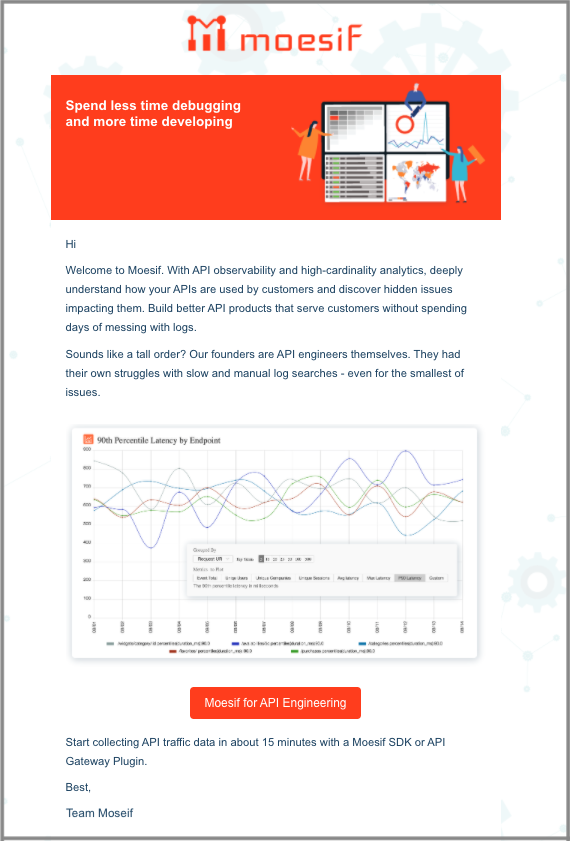
Conversely, product managers want to drive platform adoption, so their key message is more along the lines of making informed decisions to spur engagement. In our companion blog post, Top 5 Behavioral Emails Every API Product Company Should Use, we cover in detail the most important emails for API-first companies.
3. Usage-Based Emails
After the targeted welcome email it’s time to segment further, but this time using a behavioral criteria, rather than a demographic one. Since we’re most interested in driving API integration, we focus on messaging pertaining to where customers are in the integration funnel: top, middle or bottom. Using the number of API calls we trifurcate customers into three groups:
| Number of API Events/Day | Stage | Description |
|---|---|---|
| 0 Events | Top | Not yet integrated |
| 0 < Events < 1,000 | Middle | Integrated in sandbox only (smaller than free plan) |
| Events > 1,000 | Bottom | Integrated in production (larger than free plan) |
Through an integration with our MarTech tool, HubSpot, we pass the Used Event Count API parameter (the number of API calls a customer has made) from the Moesif analytics tool to the CRM. Then, based on the number of API events made, we enroll customers into one of three customized workflows:
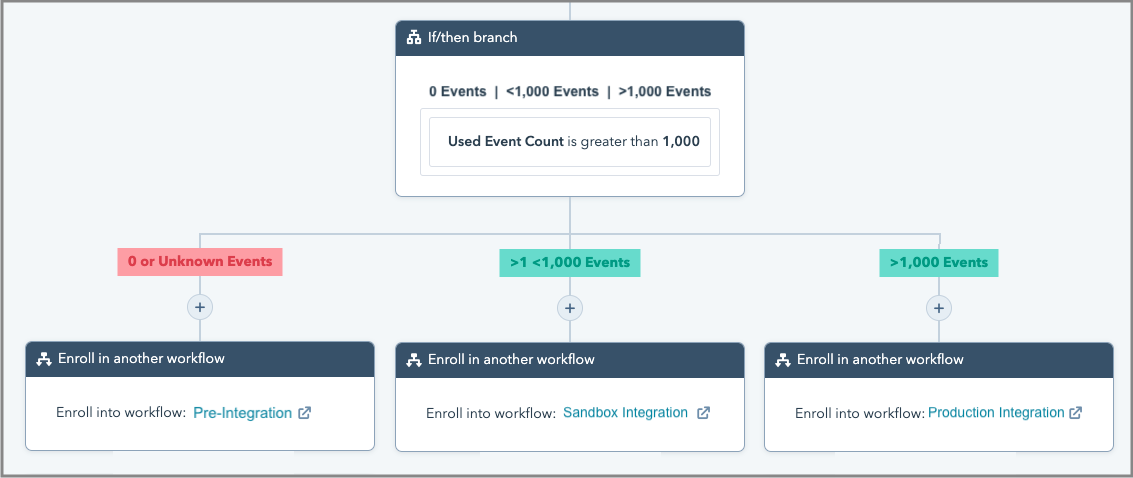
Sequence #1: Pre-Integration
If a trial user hasn’t sent any traffic over the API, we know that they haven’t integrated successfully, so the focus should be more on education and how easy it is to integrate (i.e. an awesome developer experience). Our goal is to get them to their first Hello World also called Time to First Hello World. In order to do so, we share useful articles, infographics and eBooks on developer-centric issues, and intersperse gentle nudges/offers of help from the developer relations team. By making the developer communications not too salesy, they’ll see the value they get from your company and eventually from your API. It’s also a good idea to find commonalities whenever possible to establish mutual respect, such as the comment in the email above: “Our founders being API engineers themselves. They had their own struggles with slow and manual log searches.” To do this, we eat our own dog food and set up a behavioral cohort for users who signed up in last 7 days, but didn’t send any API calls yet:
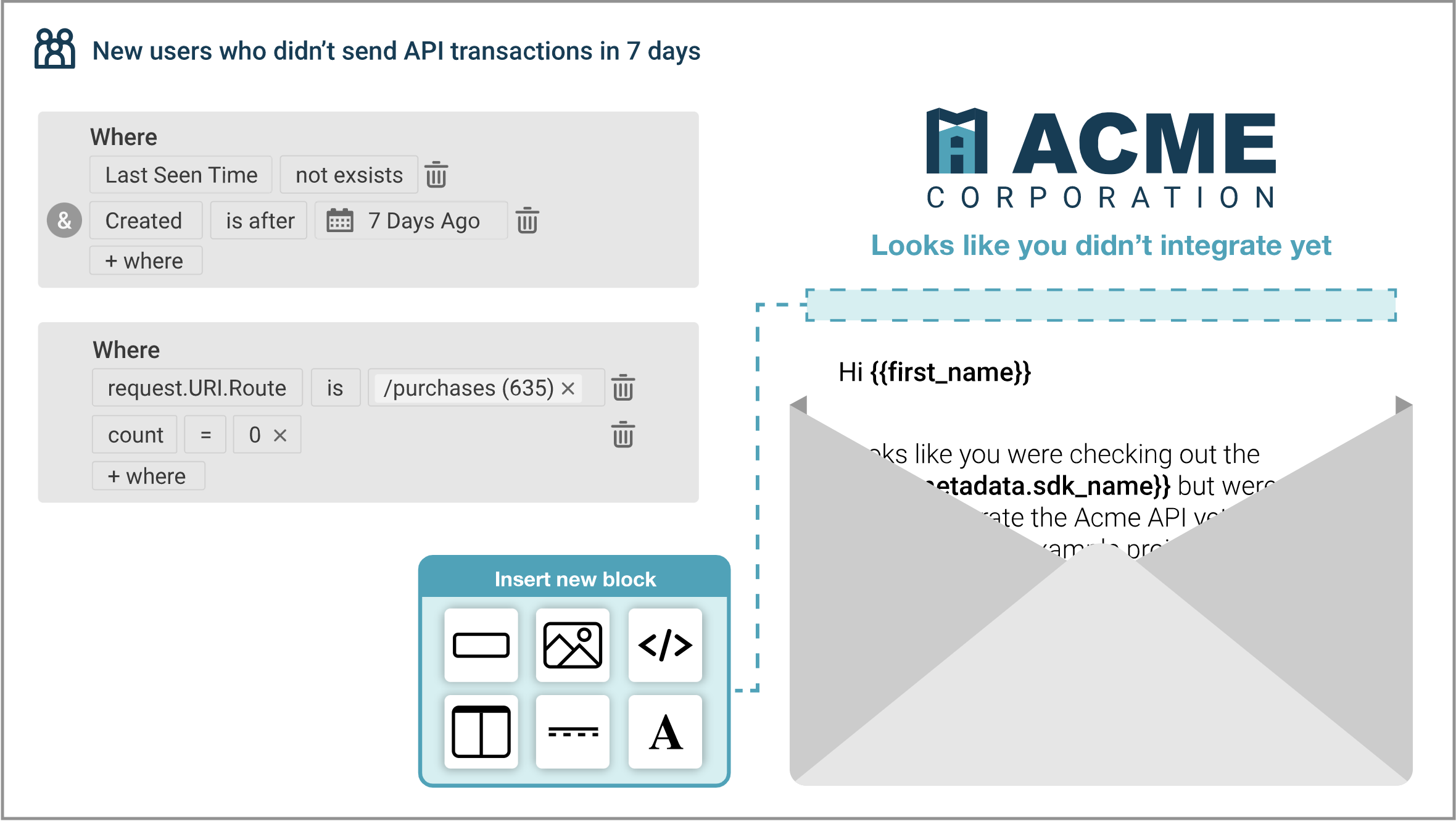
We’ve found that a cadence of 3:1 is quite successful - for every three pieces of insightful content, we send an offer of assistance. Any more frequency of “asks”, causes open rates to drop.
Example collateral that works well at the top of our integration funnel includes:
- 15 API metrics that you should be tracking infographic,
- How to master adoption and retention metrics eBook, or
- Preview our self-service demo app.
And an example nudge that isn’t too pushy:
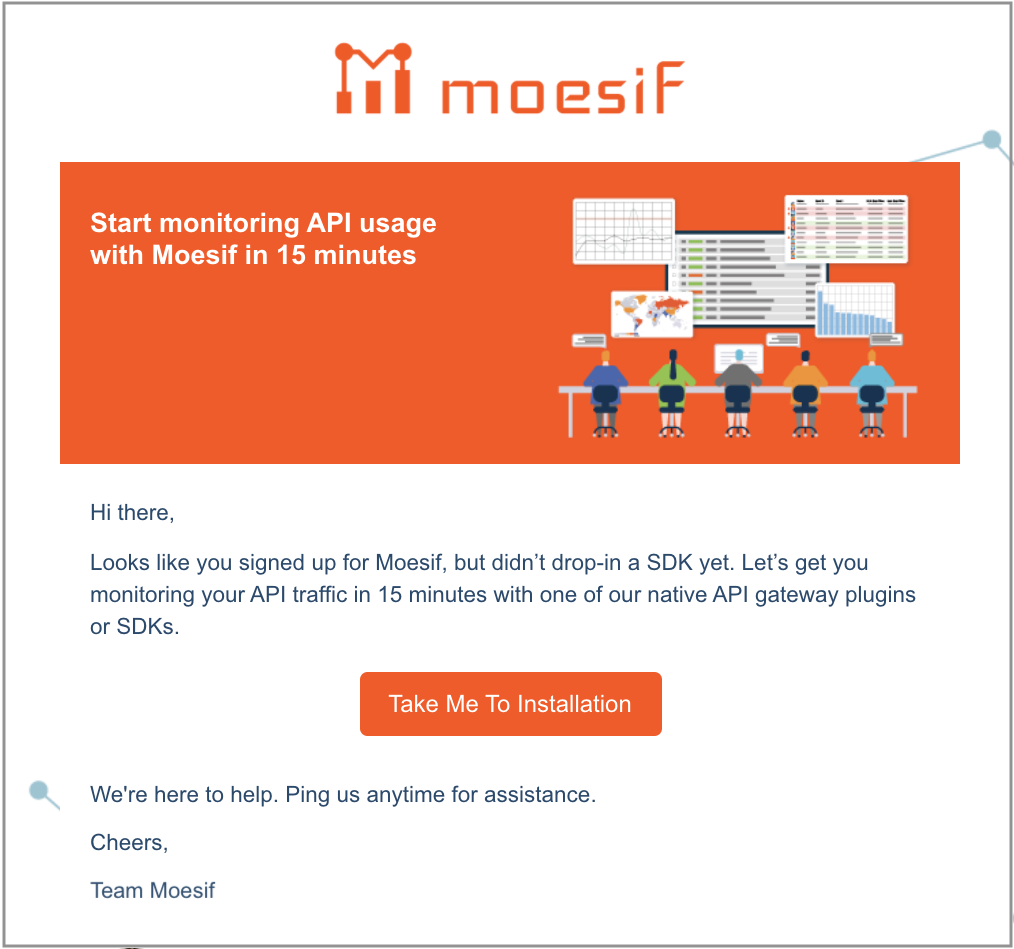
Sequence #2: Sandbox Integration
The developer has signed up and made their first API request, but something’s holding them back from taking their app to production. Instead of focusing only on developer experience, now’s the time to demonstrate the value they get from your API and help them remove any roadblocks. The time from the initial sign up to rolling out to production is sometimes called Time to First Working App or Time to First Paid App.
The best way of illustrating value is through case studies and advanced features. Show how your API platform has addressed other customers’ needs, and solved their pain points. By relating to other real-world examples, the developer will hopefully see how they too could be helped by your solution.
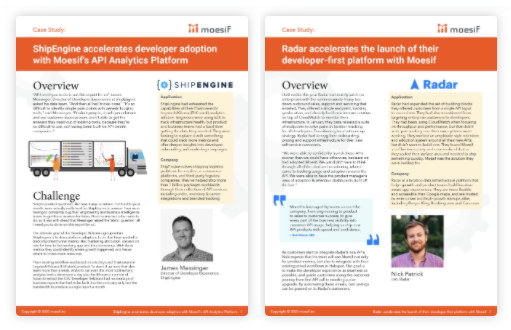
Even though you’re primarily dealing with developers, there are a lot of different stakeholders in making an enterprise sale. You have decision makers, legal and security reviews, other project priorities and functional & performance testing, that often have to be dealt with. Provide collateral and tools to empower developers on integration issues, whilst ensuring peace of mind on:
- Security and compliance,
- GDPR/CCPA support,
- Scalability and cost reduction of the supporting infrastructure.
Finally, offer developers assistance to validate their integration. Automate this email by using a trigger based on the number of API transactions they’ve made over the last few days.
 Accelerate Integration With Hyper-Personalized Emails
14 day free trial. No credit card required.
Learn More
Accelerate Integration With Hyper-Personalized Emails
14 day free trial. No credit card required.
Learn More

Sequence #3: Production Integration
Now that the customer is in production, drive the conversion around utilizing all of your API platform’s capabilities. Regularly keep them updated on your latest feature releases, comparison guides and ROI analyses. Now’s the time to further activate users by pointing out the additional value they can expect and supplemental results they can achieve. If they still have not converted to paying, these sequences are designed to address those concerns by discovering what stakeholder is holding them back. Otherwise, these sequences are perfect for driving upsells given their API usage levels.
Try Unused API Product Features
Closely aligned with the Production Integration phase above, but really applicable across any stage of the conversion funnel, is the desire to keep customers abreast of new/unused API platform features. The best way to do this is to send automated emails based on customer activity.
In our previous section on Steps to Speed API Integration we were using API call volume as the triggering event, but we could have used a much more nuanced metric. Especially in larger companies, the focus will be on things like endpoint utilization and traffic pattern analysis, with corresponding emails like:
“Have you used this particular endpoint? Let’s get you started using its new feature set.” As that new piece gets integrated and used, and as the customer goes through the full lifecycle journey, you can introduce additional endpoints by repeating the process.
“We noticed that you stopped sending traffic 7 days ago. Can we help you with endpoint X?” This is a great way to keep customers informed without manual effort:
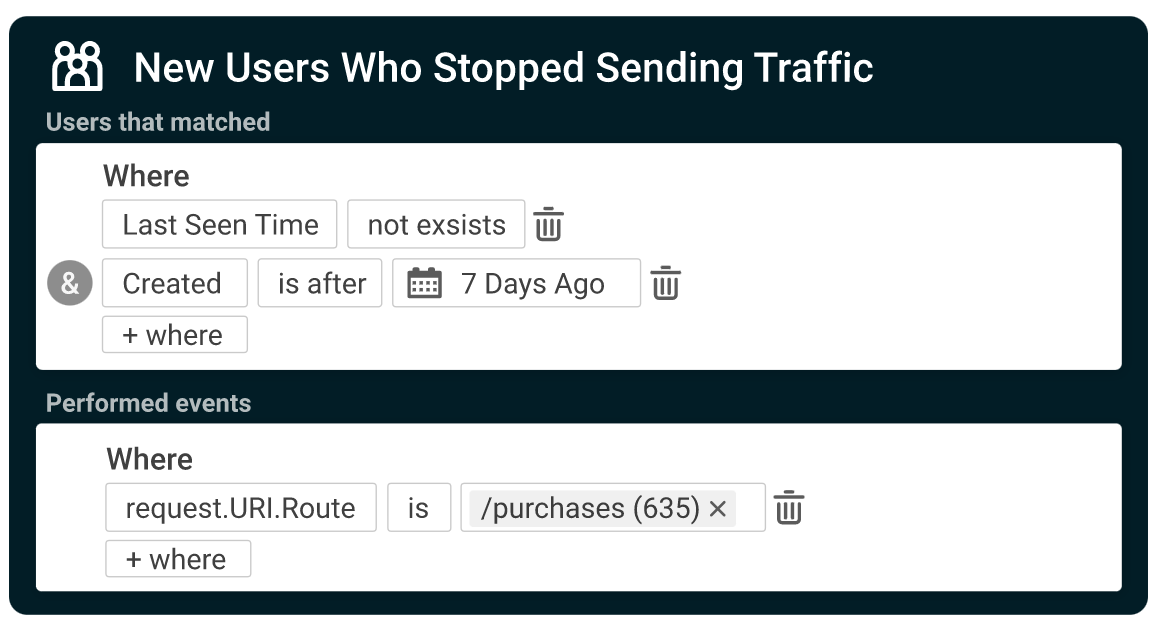
Email marketing automation tools are very good at sending regular mass marketing emails, such as newsletters, news announcements, etc. When you want to send an email based on five different actions, that were completed five times each, it’s almost impossible to do on any MarTech platform. For these behaviorally-driven customer emails, what’s really required is a custom platform like Moesif that’s designed to send emails based on specific metrics from deep within your API platform itself.
Moesif’s Behavioral Emails and Workflows feature is custom built to make it easy to configure and set up transactional emails using multiple triggers from within your product. Similarly, email workflows based on user-centric events, can be instantiated using our simple graphical interface.
Keep Informed on Subscription and Platform Issues
Customers want to be informed on what’s going on with their platform investment, but subscription and maintenance notifications can be expensive and a time sink. Moesif’s behavioral email feature makes it possible to scale customer outreach efforts, from support, CSM and engineering teams, without manual effort.
Instead of someone sending out an email notifying that a customer’s API call limit has exceeded their quota, it can now be configured and sent automatically within the Moesif API Analytics tool:
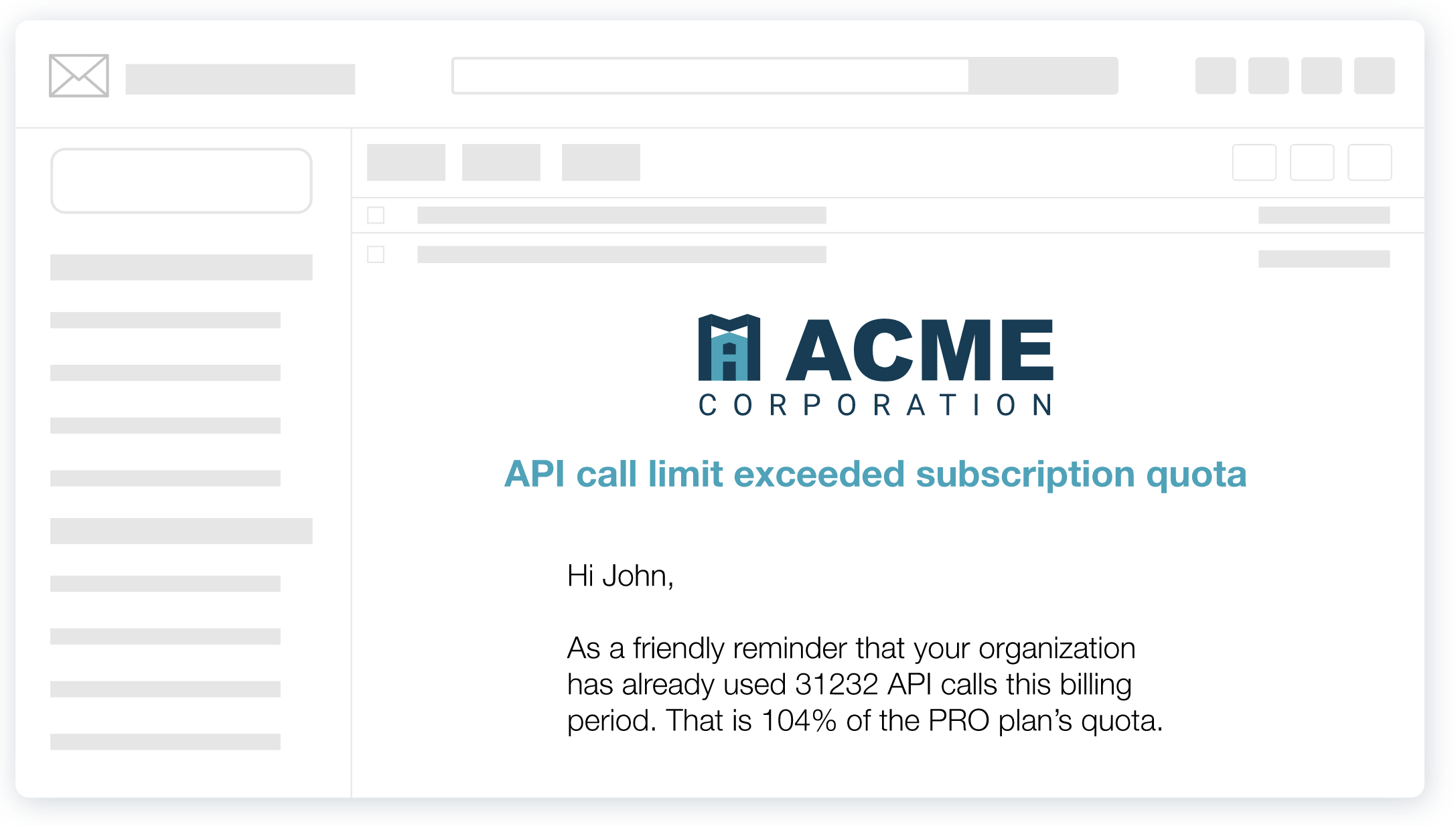
For self-service API platforms, you’re now able to economically scale developer outreach emails that cover many common subscription issues, including: subscription usage, rate limit and right-size plan emails, amongst others.
Additionally, it’s also trivial to configure Moesif to send out maintenance issues to all, or even a subset of your customers. For example, there might be instances where you want to notify only a select group of customers who might be affected by a platform vulnerability — you don’t want to email your entire base. Now you can, with our behavioral email capability.
 Guide Customers With Behavioral Emails From Moesif
14 day free trial. No credit card required.
Learn More
Guide Customers With Behavioral Emails From Moesif
14 day free trial. No credit card required.
Learn More



